Scientific Instruments
|
|
| Vacuum Electron Staining Apparatus |
Filgen's Vacuum Electron Staining apparatus enables highly efficient, reproducible,
and safe electron staining for various electron microscopy(TEM/SEM) specimens.
|
|
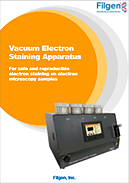
Catalogue Download |
 Overview Overview

|
【Principles】
|
What is electron staining?
Electron staining is a method for enhancement image contrast of electron
microscopy specimens which are composed with light element (eg. polymer
materials, biological specimens etc.), by binding heavy metals. For polymer
specimens, osmium tetroxide (OsO4) and ruthenium tetroxide (RuO4) are often
used. |
|
|
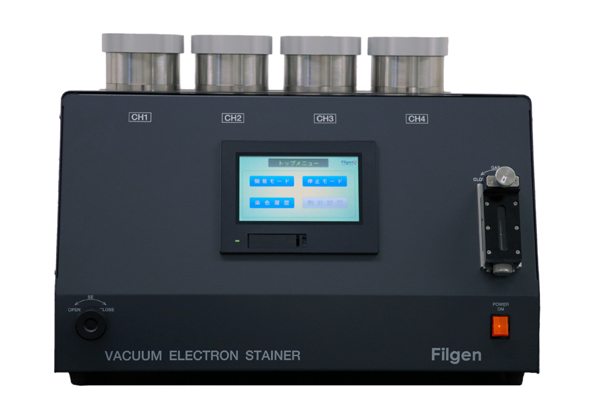 |
| |
|
What is "vacuum" electron staining?
Conventional electron staining is performed under atmospheric pressure
by exposing specimen to gaseous OsO4 or RuO4 or immerses it to those solutions.
However, it often causes overstaining or lack of reproducibility. Also,
there is a risk for operators to expose to those staining agents which
are highly poisonous.
In contrast, our patented technology, vacuum electron staining enables
more precise and safer staining by performing staining in vacuum. Staining
time and gas pressure (that is, density of staining agent) in reaction
chamber as well as timing of gas introducing and exhausting are automatically
controlled. |
【Applications】
|
◆ |
Enhancement image contrast for polymer specimens (TEM) |
| ◆ |
Fixation for polymer specimens before ultramicrotome sectioning (SEM/TEM) |
| ◆ |
Reduction of outgassing from specimens at in electron microscope chamber
(SEM/TEM) |
| ◆ |
Elimination or reduction of charging effects on non-conductive specimens
(SEM) |
| ◆ |
Embrittilement of specimens before fracturing (SEM) |
【Benefits】
|
◆ |
Safe operation: no chance to exposure to poisonous agents during staining process |
| ◆ |
High reproducibility: automated and precise control of staining time and agents density, prevention of overstaining by automated gas exhausting after ataining |
| ◆ |
Rapid and deeply staining |
| ◆ |
Effective staining also for hygroscopic specimens: staining is performed by dry gas generated from OsO4 crystal (not aqueous
solution) |
| ◆ |
Less surface contamination: effective for sectionized or otherwise thin sliced specimens |
| ◆ |
Useful for determining optimal staining condition: staining time is settable by chamber
※Only on 4-chamber models |
|
 Technologies Technologies

|
【Process of Vacuum Electron Staining】
|
| 1. |
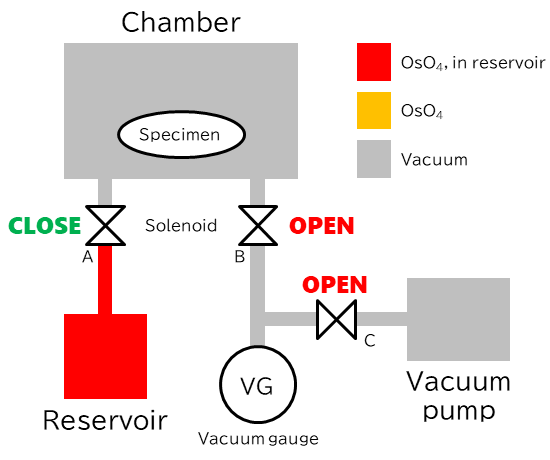 |
|
Before processing
| ◆ |
OsO4 is not introduced to chamber |
| ◆ |
Chamber is in vacuum |
|
| 2. |
 |
|
Gas introduction
| ◆ |
Solenoid A is opened, and C is closed, just after start of the process |
| ◆ |
Sublimated OsO4 is introduced in chamber gradually |
|
| 3. |
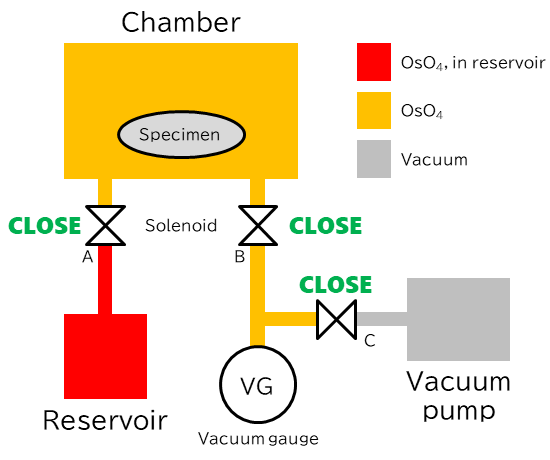 |
|
Measure of gas density
| ◆ |
All solenoids are closed after OsO4 density reaches to set level |
|
| 4. |
 |
|
Staining
| ◆ |
Now staining is running in closed chamber |
| ◆ |
Solenoid C is opened and OsO4 in piping is evacuated |
|
| 5. |
 |
|
Post staining
| ◆ |
After the elapse of set staining time, solenoid B is opened and all residual
gas is evacuated |
|
|
【OsO4 reservoir equipped with safety measures】
|
Our OsO4 reservoir is equipped with some safety measures including a mechanical
interlocking system for safety operation.
| ◆ |
Gas-tight and robust design |
|
 |
| ◆ |
Safety interlocking system with gas port integrated locking pin (see below) |
|
| ◆ |
Built-in ampoule cutter: can reduce risks for exposure to toxic OsO4 gas. |
|
| ◆ |
Observation window: can check remaining amount of OsO4 crystals |
|
| ◆ |
Detachable from main unit and can be stored in freezer |
|
| ◆ |
Dimensions: 70(W)×45(D)×120(H) mm |
|
|
【Overview for the safety interlocking system】
|
The gas port integrated locking pin of reservoir can simultaneously control
status for reservoir locking and gas supply in safe.
| 1 |
 |
Full-openrd (during operation)
| ◆ |
Reservoir: locked (undetachable) by manually inserted locking pin of reservoir |
| ◆ |
OsO4 gas: can be introduced (depends on solenoid status) |
|
|
| 2 |
 |
Half-closed (before reservoir detach)
| ◆ |
Reservoir: locked (undetachable) by manually inserted locking pin of reservoir |
| ◆ |
OsO4 gas: blocked
※residual gas in the inlet pipe must be evacuated at this step |
|
|
| 3 |
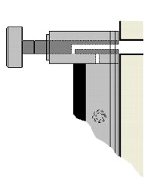 |
Full-closed (after operation)
| ◆ |
Reservoir: unlocked (detachable) |
| ◆ |
OsO4 gas: blocked |
|
|
|
|
 Products Products

|
| Model# |
VSC4TWDH
 |
VSC1R1H
 |
| Interface |
Interractive touch panel control |
Mechanical switches, knobs, digital timer/temp controller, and analog vacuum
meters |
| Staining agent |
OsO4(crystals) in glass ampoule |
| Density of staining agent |
1-10 degree |
| Staining time |
1 min. - 17 hr |
0.0 - 999.9 min. |
| Reaction chamber |
Number |
4 |
1 |
| Inner size |
86(ID) x 50(H) mm |
| Observation window |
✔(upper side) |
| Heating system |
✔(RT - 70 degC) |
| Reservoir |
Number |
1 |
| Detachable |
✔ |
| Built-in ampoule cutter |
✔ |
| Observation window |
✔ |
Storage temp.
*after detaching |
-20 ~ 4 degC |
| Gas introducing/exhausting system |
Automated control with pirani vacuum gauge, solenoids, and vacuum pump |
| Safety measure |
- Fully automated control system with interlocking
- Residual gas trap unit
Gas tight reservoir with built-in ampoule cutter |
| Size |
610(W) x 445(D) x 510(H) mm |
450(W) x 425(D) x 445(H) mm |
| Weight |
Approx.50kg |
Approx. 30kg |
| Vacuum pump |
Type |
Two-stage oil rotary vacuum pump |
| Actual pumping speed |
200 L @50Hz |
| Size |
170(W) x 515.5(L) x 249.5(H) mm |
| Weight |
31 kg |
| Accessories |
- Gas-tight OsO4 reservoir, 1 pc.
- Vacuum pump, 1 unit
- Residual gas trap unit, 1 unit
- Connecting parts
- Cleaning kit
- Instruction manual (English version, printed) |
| Price |
Ask for a quote |
Ask for a quote |
【Accessories】
|
Air Isolation Chamber
|
◆ |
Enables electron staining under anaerobic condition |
| ◆ |
Suitable for materials which have high activity or reactivity with oxygen
or moisture (eg, Negative electrode materials of Li-ion battery) |
| ◆ |
2 different sizes are available;
≫mini - 15(ID) x 6(H) mm
≫middle - 47(ID) x 15(H) mm |
| ◆ |
Compatible with all Filgen's Vacuum Electron Staining apparatus |
| |
 |
|
 |
| Air Isolation Chmber, mini (#VS-MNC) |
|
Air Isolation Chamber, middle (#VS-MDC) |
TEM Grid Holder (#VS-SGH)
|
◆ |
Holds up to 8 pcs of TEM grid |
| ◆ |
Stainless steel made; high chemical resistance |
| ◆ |
Compatible with all Filgen's Vacuum Electron Staining apparatus; 45(D)
mm |
Transportation Containar for OsO4 reservoir (#RVT-1)
|
◆ |
Enables safer transportation for OsO4 reservoir |
| ◆ |
Stainless steel made; proof pressure: 0.02 MPa |
| ◆ |
Could be used also for atorage for OsO4 reservoir |
| ◆ |
Dimensions: 198(W) x 118(D) x 102(H) mm, weight: 2.2 kg |
|
|
 Technical data Technical data

|
【Technical data #1 - SEM-EDX analysis for osmium-stained samples】
|
◆Experimental condition
|
・Material:adhesive tape
・Staining agent:OsO4
・Gas density(degree of vacuum in chamber):200 Pa
・Specimens:
(1) 1hr stained
(2) 3hr stained |
◆Result
|
【Technical data #2 - TEM images of cross-sectioned samples】
|
◆Experimental condition
|
・Material:adhesive tape
・Staining agent:OsO4
・Gas density(degree of vacuum in chamber):200 Pa
・Specimens:
(1) 1hr stained
(2) 3hr stained |
◆Result
|
 
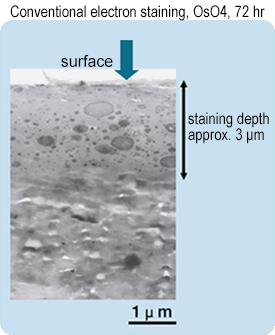 
With Vacuum Electron Staining, deeper staining with shorter staining time
is possible.
|
|
【Technical data #3 - SEM images of rubber-dispersed polymer with different
blend ratio】
|
◆Experimental condition
|
・Material:rubber-dispersed polymer with different blend ratio
・Staining agent:OsO4
・Gas density(degree of vacuum in chamber):1000 Pa
・Staining time:999.9 min.
・Specimens:
(1) Rubber polymer ratio 8:2
(2) Rubber polymer ratio 6:4
(3) Rubber polymer ratio 4:6
(4) Rubber polymer ratio 2:8 |
◆Result
|
【Technical data #4 - Reconstructed 3D images by electron tomography】
|
◆Experimental condition
|
・Material:triblock copolymer film
・Staining agent:RuO4
*Note: ruthenium staining feature is aveilable only in japan.
・Specimens:
(1) Vacuum electron staining
(2) Conventional electron staining |
◆Result
|

Uniform staining is observed from vacuum electron stained specimen. |
|
|
 References References

|
| ・ |
Rina Maeda, Takeshi Higuchi, Kenta Okuhara, Ryohei Kikuchi, Atsushi Takahara, Christopher K Ober, Hiroshi Jinnai, and Teruaki Hayakawa, Interface manipulated two-phase
nanostructure in a triblock terpolymer with a short middle segment, Polymer
Journal(2016)48, 533-538 |
|
|